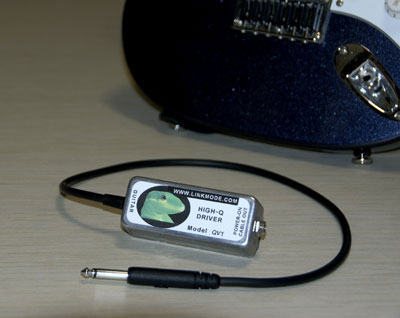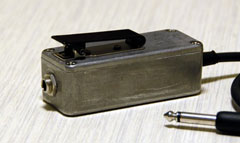(1) Impedance matching - The QV1 has very high input impedance and very
low output impedance to match the pickup to the cable. This has two benefits:
- An electric guitar pickup gives its best frequency response when connected to a high
impedance load. Any instrument cable plugged directly into the guitar will change the tone.
A long, high-capacitance cable will reduce the bandwidth dramatically and muddy the tone.
Impedance matching eliminates this problem; instrument cables will no longer affect the tone.
- If the guitar is connected directly to a long instrument cable, changing the guitar volume
control setting also changes the tone. Impedance matching eliminates this problem.
(2) High-Q filter - Even after impedance matching has eliminated the effect of the instrument cable,
the bandwidth is still limited by the internal inductance and capacitance of the pickup itself.
The output falls off rapidly above the pickup resonant frequency,
typically at 4,000 to 9,000 Hz.
The high-Q filter gives a large gain boost just where the pickup output begins
to fall off. The "3 dB bandwidth" is extended by more than an octave. A pickup that originally
had 5,000 Hz bandwidth will now have about 13,000 Hz bandwidth.
(3) Voltage gain - The QV1 has a moderate, 6 dB nominal voltage gain. Some benefits are:
- Pickup design is a trade-off among many objectives, including wide bandwidth, high output,
low string pull, and long sustain. Adding 6 dB of active gain makes it possible
to choose a pickup with lower output but better bandwidth, string pull, and sustain.
- Any noise from the instrument cable is effectively reduced by 6 dB, giving cleaner sound.
The QV1 itself contains a high-performance, low-noise JFET operational amplifier that
is very quiet.
(4) High input level - To handle high output pickups, the QV1 combines rail-to-rail output,
moderate gain, and a 9-Volt battery. It can take up to 4 Volts peak-to-peak input without
clipping.
(5) Effects - Guitar effects processors work fine with the QV1. Volume and tone controls
on the guitar also operate normally.
(6) Built tough - This unit can take a lot of abuse and just keeps on ticking.
- Die cast aluminum housing with four-bolt cover and riveted steel belt clip.
- Good quality cable with molded plug. This is one half of a Planet Waves®
PW-CGT-05 cable.
- Input, output, and battery terminals are all protected against ESD (electrostatic
discharge).
- Internal circuitry is protected against battery reversal.
- There are no external control knobs, switches, or lights - nothing to break.
- Powers on when an instrument cable is inserted. Powers off when the user (hopefully)
remembers to unplug the instrument cable.
(7) See
impedance & high-Q for more technical details.


